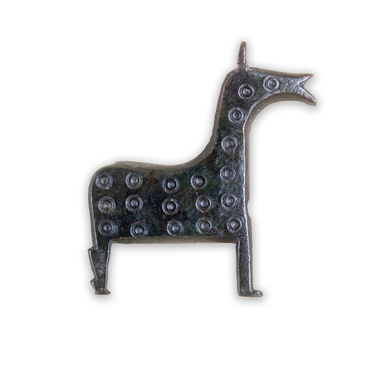Mirrors first appeared in East Asia in the 2nd millennium BC. Bronze mirrors were made in China in limited quantities until the middle of the 1st millennium BC. It is considered, that they were used as sacral amulets. Mirrors turned from magical attributes into household items at the turn of the millennia; this led to their mass production.
Products were imported to the Golden Horde from various countries, or they were manufactured in local workshops based on imported samples. For example, artisans could use Chinese technology. Bronze, billon (material with small amount of a precious metal), or special light alloy with the addition of tin was used to make mirrors. In the early modern era, the alloy, containing copper, tin metal and lead was used for mirrors. Such bronze composition was hard and difficult to process. At the same time, it had excellent casting properties and reflectivity.
Mirrors made of such material were popular in Central Asia, China as well as in the Roman Empire. Since these products were extremely expensive, only wealthy people could afford them.
As a rule, the product was manufactured in a round shape, but there were some samples in other cultures with festooned, wavy edges.
A mirror was often worn on the belt; there were special leather or fabric protective covers used for it. They polished the mirror to shine. Sometimes the surface was coated with an additional substance that intensified the reflective property.
Mirrors were mainly used for cosmetic and household purposes. However, many ethnic groups used the mirror as a part of grave goods. It was put in the protective case and placed near the head.
In bygone days it was believed, that the mirror would help to see evil spirits and drive them off. There were also other superstitions connected with this item.
For example, a broken mirror heralded the separation of the spouses. In many countries, the mirror was connected with the Sun Goddess that is why the metal was chosen very carefully. The color and shine should resemble the Sun; the surface was made sure that it would not dim.
Products were imported to the Golden Horde from various countries, or they were manufactured in local workshops based on imported samples. For example, artisans could use Chinese technology. Bronze, billon (material with small amount of a precious metal), or special light alloy with the addition of tin was used to make mirrors. In the early modern era, the alloy, containing copper, tin metal and lead was used for mirrors. Such bronze composition was hard and difficult to process. At the same time, it had excellent casting properties and reflectivity.
Mirrors made of such material were popular in Central Asia, China as well as in the Roman Empire. Since these products were extremely expensive, only wealthy people could afford them.
As a rule, the product was manufactured in a round shape, but there were some samples in other cultures with festooned, wavy edges.
A mirror was often worn on the belt; there were special leather or fabric protective covers used for it. They polished the mirror to shine. Sometimes the surface was coated with an additional substance that intensified the reflective property.
Mirrors were mainly used for cosmetic and household purposes. However, many ethnic groups used the mirror as a part of grave goods. It was put in the protective case and placed near the head.
In bygone days it was believed, that the mirror would help to see evil spirits and drive them off. There were also other superstitions connected with this item.
For example, a broken mirror heralded the separation of the spouses. In many countries, the mirror was connected with the Sun Goddess that is why the metal was chosen very carefully. The color and shine should resemble the Sun; the surface was made sure that it would not dim.

